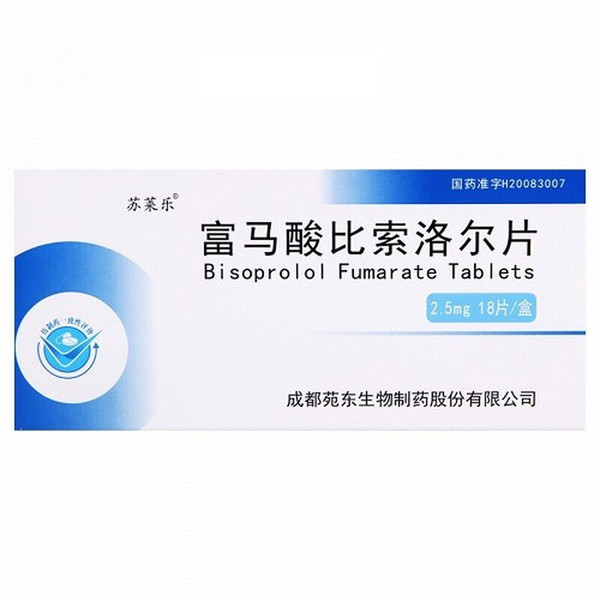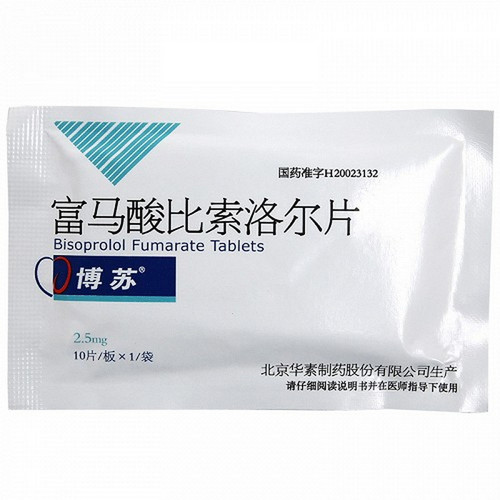Product Overview
[Drug Name]
Generic Name: H Bisoprolol Fumarate Tablets
Trade Name: SuLaiLe H Bisoprolol Fumarate Tablets 2.5mg*18 Tablets
Pinyin Code: SuLaiLe HFuMaSuanBiSuoLuoErPian 2.5mg*18 Tablets
[Main Ingredient]
The main ingredient and chemical name of this product is: 1-{4-[2-(1-methylethoxy)ethoxy]methyl]-phenoxy]-3-[(1-methylethyl)amino]-2-propanol fumarate.
[Properties]
See package insert for details.
[Indications/Main Functions]
For the treatment of essential hypertension and angina pectoris.
[Specifications]
2.5mg*18 tablets
[Dosage and Administration]
Oral. Once daily, starting dose 2.5mg, maximum daily dose not exceeding 10mg. Please follow your doctor's instructions. No dosage adjustment is required for patients with mild or moderate hepatic or renal impairment. For patients with advanced renal impairment (muscle-to-hepatic clearance <20 ml/min) or severe hepatic impairment, the daily dose should not exceed 10 mg.
[Adverse Reactions]
1. Mild fatigue, chest tightness, dizziness, bradycardia, drowsiness, palpitations, headache, and lower limb edema may occur initially, but these symptoms will subside or disappear spontaneously with continued medication. 2. In rare cases, gastrointestinal disturbances (diarrhea, constipation, nausea, abdominal pain) and skin reactions (such as erythema and itching) may occur. 3. A significant drop in blood pressure, slow pulse, or atrioventricular conduction disturbances may occasionally occur. 4. Tingling or cold extremities may occur, and in rare cases, muscle weakness, muscle cramps, and decreased tearing may occur. 5. In patients with intermittent claudication or Raynaud's phenomenon, symptoms may worsen in the initial treatment period, and those with pre-existing myocardial dysfunction may also experience aggravation. 6. Increased airway resistance may occasionally occur.
[Contraindications]
1. Shock, atrioventricular conduction disorders (second- and third-degree atrioventricular block), sick sinus syndrome, sinoatrial block, bradycardia (less than 50/min), hypotension, bronchial asthma, and advanced peripheral circulatory disorders.
2. Adrenal adenoma (pheochromocytoma). This product should only be taken after taking an alpha-blocker.
[Drug Interactions]
1. The antihypertensive effect of this product is enhanced when used concomitantly with other antihypertensive drugs. 2. This product may slow the heart rate when used in combination with reserpine, methyldopa, clonidine, or chlorpheniramine. 3. When used concomitantly with reserpine, this drug must be discontinued several days later. 4. Combination with nifedipine may enhance the antihypertensive effect of this product. 5. When used concomitantly with verapamil, diltiazem-type calcium channel blockers, or other antiarrhythmic drugs, the patient must be monitored as hypotension, bradycardia, and other potential side effects may occur.
[Precautions]
1. Use with caution in patients with diabetes and acidosis who experience significant blood sugar fluctuations. 2. Use with caution in patients with impaired pulmonary function or severe hepatic or renal insufficiency. 3. When discontinuing treatment, the dose should be gradually reduced daily. Dosage reduction is often necessary when used in combination with other antihypertensive medications. 4. If an overdose causes bradycardia or hypotension, discontinue this drug. If necessary, the following medications may be used alone or continuously: atropine 0.5mg-2.0mg IV, iprostatol slow IV infusion in appropriate doses, and glucagon 1mg-5mg (or 1mg-10mg). 5. Due to its antihypertensive effect, this drug may impair the patient's ability to drive or operate machinery, especially when first taking it or switching medications, and when taken with alcohol. However, it will not directly affect a person's reaction time.
[Children's Use]
This drug should not be used.
[Elderly Patients' Use]
Please follow your doctor's advice.








